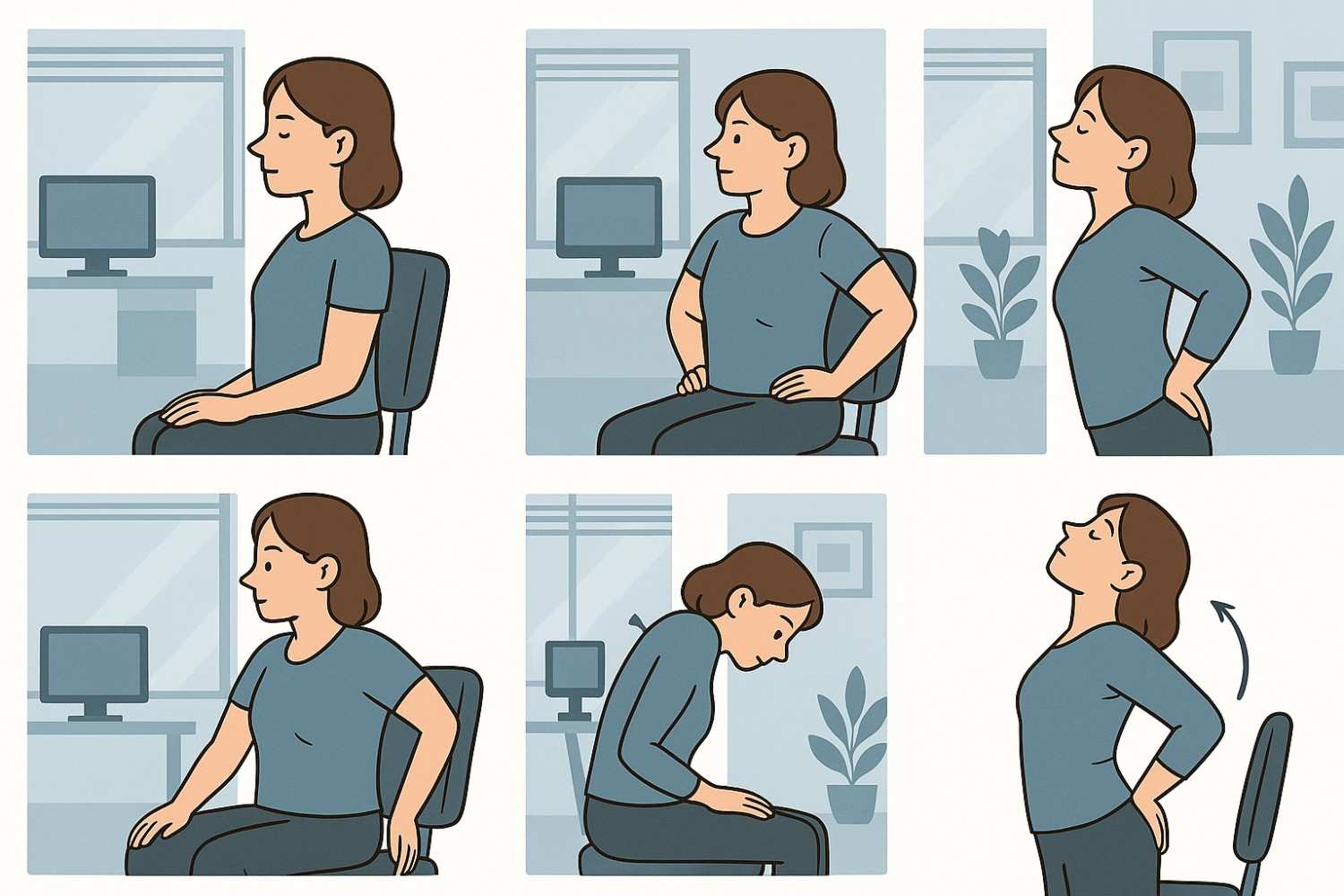Introduction
In today’s digital world, most professionals spend hours glued to a screen—slouched over laptops, hunched at desks, or sitting in poorly designed chairs. While we may not notice it immediately, these prolonged postures slowly wreak havoc on the neck and back, leading to stiffness, discomfort, and sometimes chronic pain. Whether you’re working from home or at the office, poor ergonomics and sedentary routines are common contributors to musculoskeletal issues.
The good news? You don’t need a gym or fancy equipment to combat this. A few targeted, simple physiotherapist-approved exercises, done consistently, can help you maintain mobility, improve posture, and reduce strain on your spine. In this blog, we’ll introduce five effective exercises that you can easily incorporate into your workday to keep neck and back pain at bay. Your body was made to move—so let’s get started and give it the relief it deserves!
✅ 1. Chin Tucks (Neck Retractions)
Why It Helps:
Chin tucks strengthen deep cervical flexor muscles and counteract the forward head posture, common in computer users.
How to Do It:
- Sit or stand tall with your shoulders relaxed.
- Gently draw your chin straight back, as if you’re making a double chin.
- Hold for 5 seconds and relax.
- Repeat 10 times, 2–3 times a day.
Tips:
Don’t tilt your head up or down—just glide it backward. You should feel a stretch at the base of your skull.
✅ 2. Shoulder Blade Squeezes (Scapular Retractions)
Why It Helps:
This exercise activates the rhomboids and middle trapezius, improving upper back posture and relieving mid-back tension.
How to Do It:
- Sit or stand with your arms by your side.
- Squeeze your shoulder blades together as if you’re pinching something between them.
- Hold for 5–10 seconds.
- Repeat 10–15 times.
Tips:
Avoid lifting your shoulders upward. Focus on drawing them straight back and down.
✅ 3. Seated Spinal Twists
Why It Helps:
Spinal twists mobilize the thoracic spine and reduce stiffness from prolonged sitting.
How to Do It:
- Sit upright in your chair with both feet flat on the ground.
- Place your right hand on the back of your chair and your left hand on your right thigh.
- Gently twist your torso to the right, looking over your shoulder.
- Hold for 10–15 seconds, then repeat on the left side.
- Do 3 reps on each side.
Tips:
Don’t force the twist. Breathe deeply to help relax the spine.
✅ 4. Cat-Cow Stretch (Chair or Floor Version)
Why It Helps:
This dynamic stretch improves spinal flexibility and relieves tension in both the neck and lower back.
How to Do It (Chair Version):
- Sit at the edge of your chair, feet flat on the ground.
- On an inhale, arch your back and lift your chest (Cow Pose).
- On an exhale, round your back and tuck your chin to your chest (Cat Pose).
- Repeat slowly for 10–15 reps.
Tips:
Coordinate your movement with your breath for maximum benefit.
✅ 5. Standing Back Extensions
Why It Helps:
A great counter-stretch for those sitting all day, this helps decompress the lumbar spine and correct forward-flexed posture.
How to Do It:
- Stand up straight with your hands on your hips.
- Gently lean back as far as is comfortable, keeping your knees straight.
- Hold for 5 seconds and return to upright.
- Repeat 8–10 times.
Tips:
Avoid over-arching or bouncing. Keep the movement slow and controlled.
Bonus Tips for Desk Workers
- Take a break every 30–45 minutes. Even 1–2 minutes of movement helps.
- Adjust your workstation: Ensure your screen is at eye level, chair supports the lower back, and wrists are neutral while typing.
- Stay hydrated: Dehydrated muscles fatigue faster, increasing the risk of tension.
- Incorporate stretching apps or alarms: Tools like “Stretchly” or phone reminders can prompt breaks.
Conclusion
Neck and back pain don’t have to be an inevitable part of working a desk job. With just a few minutes a day, the right exercises can undo hours of slouching and keep your body resilient. Consistency is key—doing these five movements regularly will not only ease current discomfort but also prevent future issues. Combine them with an ergonomic setup and short, frequent breaks for best results.
Remember, your body thrives on movement. If your pain persists or worsens, consult a licensed physiotherapist to personalize your care. Don’t wait for pain to become chronic—start moving smart today, and your spine will thank you tomorrow.
– Dr. Aprajeeta Chouhan, Assistant Professor
Faculty Of Physiotherapy, Madhav University

